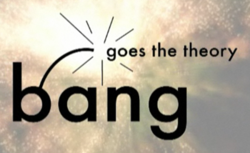Bang Goes the Theory
| Bang Goes the Theory | |
|---|---|
 |
|
| Genre | Factual, science and technology |
| Presented by |
|
| Country of origin | United Kingdom |
| Original language(s) | English |
| No. of series | 8 |
| No. of episodes | 64 – plus 3 specials (list of episodes) |
| Production | |
| Producer(s) | Ed Booth series 1,2,3 and 8. Paul King series 4,5,6,7. |
| Location(s) | Sussex |
| Editor(s) | Dermot Caulfield |
| Running time | 30 minutes |
| Production company(s) |
BBC Open University |
| Release | |
| Original network |
BBC One BBC HD BBC One HD |
| Picture format | 16:9 1080i |
| Audio format | Stereo |
| Original release | 27 July 2009 – 5 May 2014 |
| Chronology | |
| Related shows | Tomorrow's World |
| External links | |
| Website | |
Bang Goes the Theory or Bang was a British television science magazine series, co-produced by the BBC and the Open University, that began on 27 July 2009 and ended on 5 May 2014 on BBC One. Originally presented by Liz Bonnin, Jem Stansfield, Dallas Campbell and Dr. Yan Wong, the show employs a hands-on approach to test scientific theory and demonstrate how science shapes our world. From series seven, Maggie Philbin replaced Dallas Campbell as a main presenter and Yan Wong no longer appeared.
The co-production between the BBC and the Open University was announced in June 2009 and was commissioned by Jay Hunt, controller of BBC One, for ten 30 minute episodes. It promises to "put scientific theory to the test" and examine "how science shapes the world around us". During the announcement, Hunt stated that the series "brings popular science back to the very heart of BBC One", referring to the long-running BBC series Tomorrow's World, which ran from 1965 to 2003 and was cancelled following falling ratings. Comparing Bang Goes the Theory to Tomorrow's World, series editor Dermot Caulfield said,
Rather than simply be a reporting vehicle on what’s new in the world of science, we want to roll up our sleeves, stick our hands in the dirty gubbins of the engine and find out why, what, or where science is happening.
Dr. Stephen Serjeant (Reader in Cosmology at the OU), and Dr Ian Johnston (Lecturer in Engineering for the OU) were the two academic team leaders for the production, covering disciplines including geology, astrophysics, neuropsychology and zoology. The studio elements of the series were initially recorded in a building that housed the supersonic wind tunnel fans at RAE Bedford in Bedfordshire and was also the testing facility for the first prototype Harrier Jump Jet V/STOL aircraft. They were later recorded in the old linear accelerator building on the University of Sussex campus near Brighton, where Jem Stansfield has his workshop. As of Series 6 (from March 2012) no studio was used and linking sections were filmed on location.
...
Wikipedia
